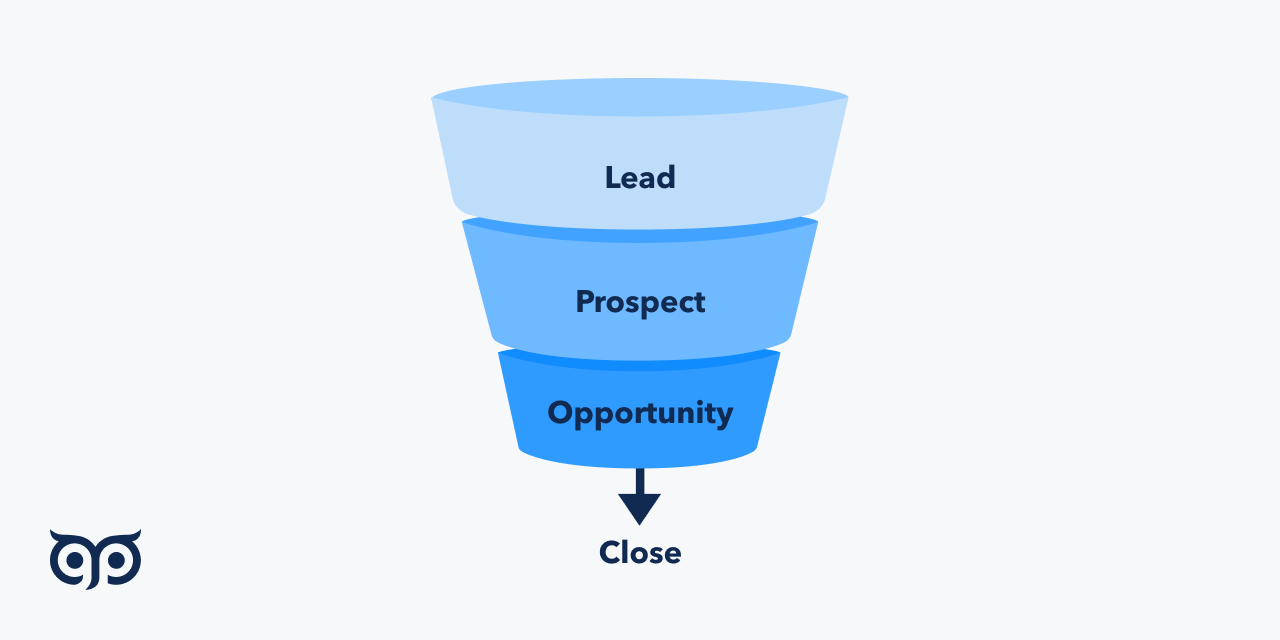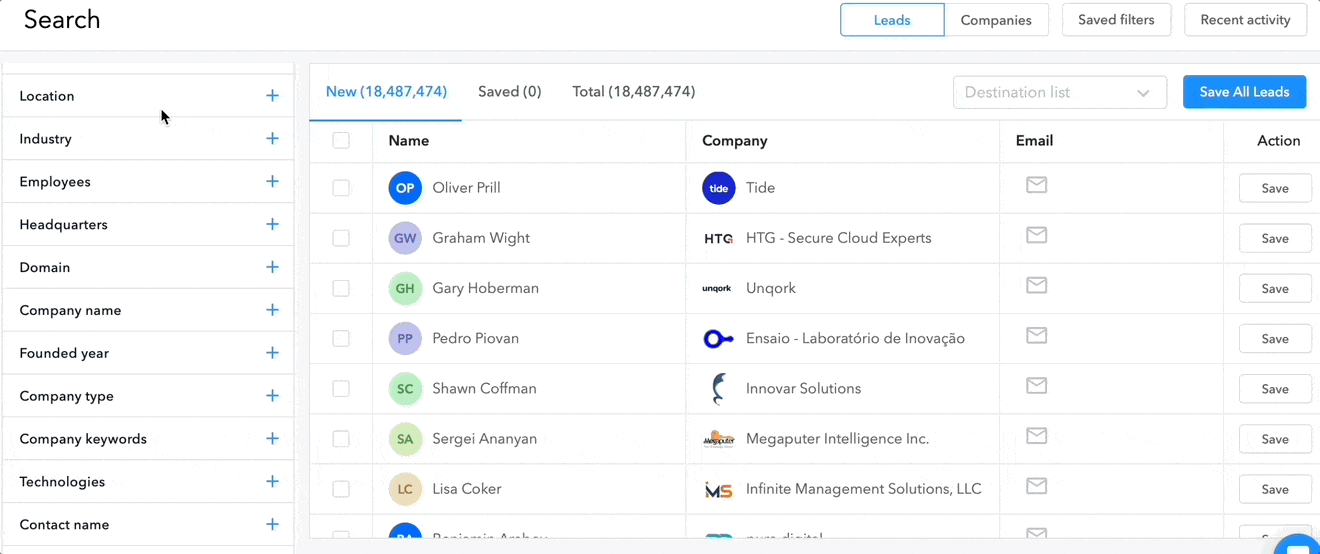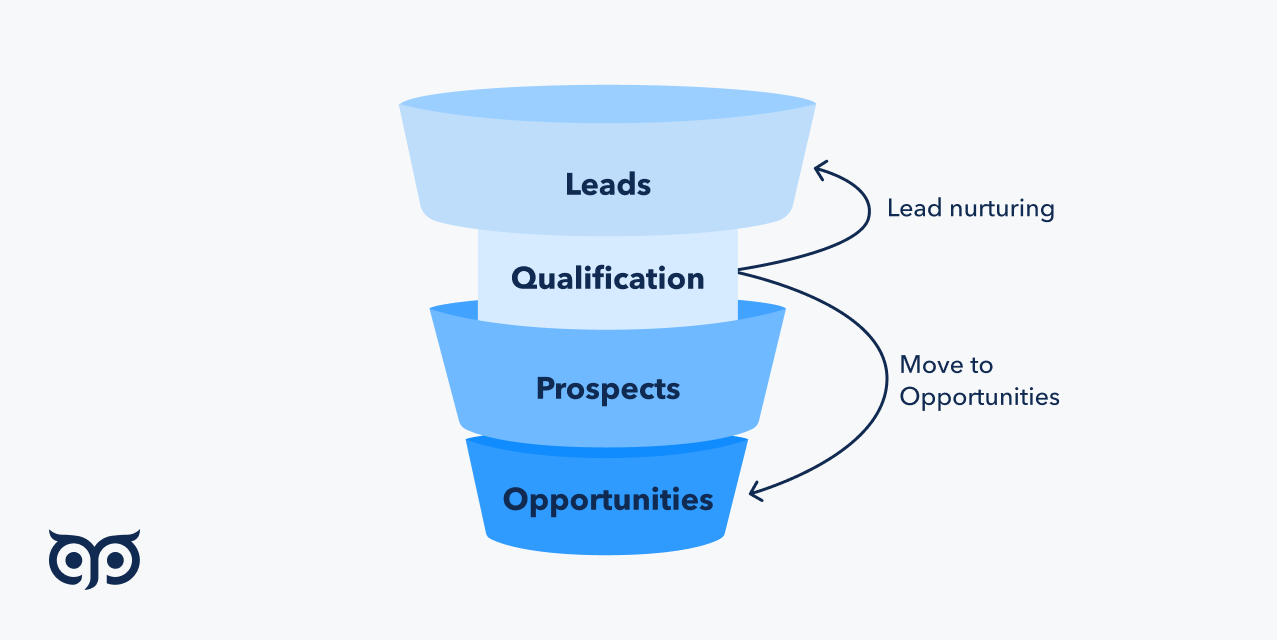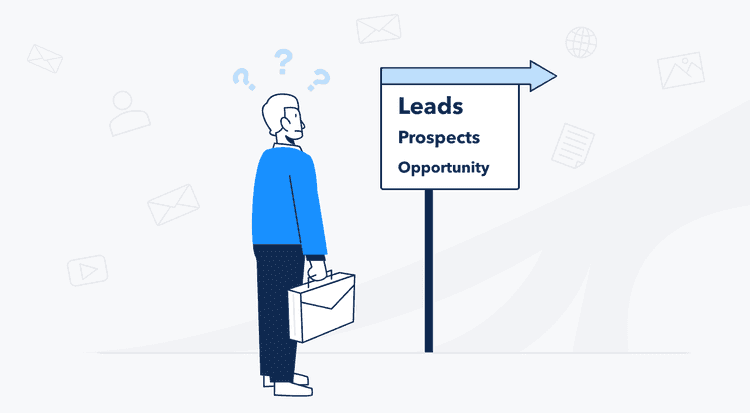- What are the definitions of lead vs opportunity vs prospect?
- What is the difference between a lead and a prospect?
- Lead vs prospect: from one stage to another
- What is the difference between lead and opportunity?
- From lead to opportunity potential customer processes
- Qualified lead vs opportunity: what is the difference
- Prospect to opportunity potential client transformation
- Summary: lead vs opportunity vs prospect differences
If you don’t separate these three concepts of potential customers - lead vs prospect and opportunity, you may find that your product/services will not sell the way you want them to. Why?
Because these concepts have different meanings, and the contacts in your sales funnel are at different stages. If you use the same approach to, for example, leads and sales opportunities, you risk missing out on some deals as some particular approaches may be effective for the first category but useless for the second one.
By classifying potential customers with different concepts, there will be an opportunity to focus on those contacts who are ready or almost ready to purchase, leaving unqualified leads for later consideration.
What are the definitions of lead vs opportunity vs prospect?
B2B leads for sale, prospects, and opportunities are part of one sales process. Often these processes follow one after the other:
- A sales specialist finds leads
- Qualifies leads, and they become prospects
- Turns them into opportunities
- And then it all ends up in sales
The sales process is not always like this, and can start immediately with the prospect: you immediately find contacts matching your Ideal Customer Profile or part of the leads need a lead nurturing. But the standard scheme looks like this 👇
Prospect, lead, opportunity: scheme

Now let’s consider each of their definitions.
What are B2B leads for sale?
B2B leads are potential customers who are probably not yet familiar with your company or may also be those who show interest in your products/services.
How can you get a list of these contacts?
These people are likely to leave their contacts - phone number, email, etc., for example, by filling out a form to receive newsletters on the site or by visiting your experts' online broadcasts. Or, of course, you can find them with the help of recommendations or some useful tools.
Note. Even though B2B leads show interest, they may or may not match your Ideal Customer profile and not become prospects later on. To what extent do some contacts meet the criteria and are ready to buy - all this is found out by analyzing data about them and communicating with them.
Find partially qualified leads with the GetProspect Email finder tool and its various filters: Job title, Departments, Headquarters, Company type, Technologies, and so on. More prospective leads - more deals.
Try it nowWhat is the prospect?
Prospect is a potential customer that has shown interest in your product/service and has the big potential to become your regular customer. Prospects also can be people who have not yet shown interest in your product or service and have not said they want to make a purchase - they just meet the criteria of the target market.
Prospect vs lead main differences: example
Prospect versus lead already meets certain criteria, that is, it is qualified, in part or in full.
For instance, a potential customer lives geographically where the company's target audience lives, uses technologies from a similar category to your product/service and has the budget to buy your product.
You can find prospects in different ways. One of the perfect ones is to search in GetProspect B2B database with 17+ advanced filters.

Or you can get prospects by qualifying your leads lists, after collecting all important data about them. You can do this by sending cold emails, making cold calls, or using data enrichment in GetProspect.
What is an opportunity?
Opportunity is potential customers close to buying and to becoming your customers, they are potential deals. They represent a greater value than the leads and prospects.
Difference between lead and opportunity
Those contacts who qualify, meet certain criteria (ideal customer profile), jump over the prospect stage, or go straight from the lead stage can get to the opportunity stage. They have a high business value or a high probability of closing.
What is the difference between a lead and a prospect?
Difference between leads and prospects #1: Various strategies
Well, first of all, you have already realized that lead generation vs prospecting have different concepts, and each category should have a different approach to sales. Two separate strategies are needed for each group.
Prospect vs lead: strategy differences
The strategy for leads focuses on attracting and developing interest through marketing content and communication aimed at a wide audience.
For prospects, the focus is on an individualized approach to already qualified leads, including direct appeals, personalized offers, and active negotiation, as these customers are already precisely identified as meeting your ideal customer criteria.
Difference between a prospect and a lead #2: Way to opportunities
Leads will stay at the same level/stage until they are qualified as potential customers.
Prospects found, e.g., with search tools, or those moving from the lead stage with qualifications, will switch to the next stage if they really need a new solution (you need to know those by communicating with them), are interested in your product, start to use a free trial, and so on.
That is, in the case of leads, the transition to the next stage only decides the moment of qualification, but in the case of prospects, it is a series of moments which will either be followed by opportunities or not.
Lead vs prospect: from one stage to another
To transforming a lead into a prospect, you need, as we have mentioned before, qualification.
Lead, prospect, opportunity: scheme example

To turn B2B leads for sale into prospects you need
- Develop evaluation strategies in advance to prioritize contacts.
- Сreate sales lead qualification question scripts for calls or mailings to properly communicate with them to get the right answers.
In the course of qualification, you will find out which of the leads
- fit your target client,
- are open to a dialogue about a future purchase,
- who is not ready to buy,
- who needs to be sent to lead nurturing.
An example of what is meant by lead nurturing
- Publishing valuable content on your blog, Youtube channel, or other channels where you interact with your target audience, publishing useful content for them.
- Start a chain of mailings that will be interesting to the leads, and increase their interest in your product, adding lucrative offers, and solving their pain points.
- By moving your customers to this stage, you are working on the future, that is, don’t miss the opportunity to make a deal with them in the future.
What is the difference between lead and opportunity?
The difference between lead and opportunity potential is in the level of readiness to purchase. In the first case, you don't know yet how ready a person is to buy, in the second, you already understand that, most likely the purchase will be made.
Opportunities are already potential customers that you need to pay special attention to in order to bring things to a deal - it's not for nothing that this stage is called - ONE STEP TO A DEAL.
And one more… At the stage of opportunity, you can already make an offer, at the stage of lead – no, cause people usually are not ready to buy at that moment.
From lead to opportunity potential customer processes
#1. Criteria for the opportunity potential client for all departments
To convert leads into opportunities, set a set of criteria for identifying opportunities across all teams in your company - in marketing and sales.
That way, you reach only those leads that really fall into that category, are one step away from a deal, and you do not switch into opportunities that part of the database that is actually in the prospecting phase or not ready to buy at all and requires additional communication/processing back at the lead stage.
Such a clear rule and strategy for the marketing and sales team will help avoid inconsistencies between departments, missed opportunities, and chasing the wrong leads.
All departments will have the same vision of who should be on the list of «opportunities», as a result, the right contacts will be selected, and the people who really want it or most likely want it will be brought to the deal/purchase, and the company will get the necessary results in the form of sales.
#2. More data for a move to opportunity potential customer
This is again about the qualification stage. Only if you have one set of criteria at the transition of leads to prospects, you have another set of criteria at the transition of leads to opportunities.
For example, make sure the leads are from the right industry, your product can help them achieve their business goals right now, solve their pain points right now, and their budget is enough for your product at this point.
Before a lead move to the stage of sales opportunities, you need to have prior communication with them. That is, either they appealed to you for a solution, or you contacted them and learned the details that allow you to move the person to the stage of opportunities to make a deal.
You can enrich data directly from a Google spreadsheet with the help GetProspect add-on.
Also analyze other sources - look at the info on social media, what data in the Google search page, then call, and so get valuable information that will help move some of the leads to opportunities.
Qualified lead vs opportunity: what is the difference
The difference between lead prospect and opportunity is potential customers of the second definition are much closer to a deal than those in the first.
As we said earlier, you can send a proposal, as opposed to leads, at the opportunity stage. And here, you're more likely to get a purchase than to do a mailing with offers to subscribe to the product on the leads or even to the end of not knowing whether they really need it.
Prospects will remain prospects until they move into the opportunity phase and from there to the deal. Some of them may drop out because of various factors-some unforeseen circumstances, cooling of interest, and so on.
Remember. Unforeseen circumstances, cooling interest of the prospect - all this does not mean that such contacts should be crossed out. If there is a chance, you just need to continue communication with them, to fuel interest in the products, until the moment when again, this list of contacts will not decide to talk about the deal.
Prospect to opportunity potential client transformation
You need to communicate with the prospect. They, unlike leads, are already qualified, and there are fewer questions. That is, at this stage, there are already those who fit the potential client, and you need to understand how to switch them to sales opportunities.
The most important thing to find out is whether the potential client is suitable for your product or service in general. If not, then, such a prospect doesn't move forward on the stage. If yes, then move on 💃.
It is important to communicate with the person making the decision, find out how urgently you need to solve the pain points, and tell the person exactly how you can help them.
Be more persuasive to conduct product's demo and clearly show that it will be useful to their team. Provide cases of similar companies that have achieved good results with your product, for example, in just a few months.
Summary: lead vs opportunity vs prospect differences
- Leads are potential customers who show interest in products or services.
- Prospect versus lead already meets certain criteria, that is, it is qualified, in part or in full.
- Opportunity potential is potential customers close to buying and to becoming your customers, they are potential deals.
- Difference between leads and prospects: various strategies and ways to opportunities.
- To convert leads to prospects, you need to qualify leads, if you can't convert them to prospects immediately use the lead nurturing process.
- The difference between lead and opportunity is that in the first case, you don't know yet how ready a person is to buy, whether they can do it, and so on., because there was no qualification stage, and in the second case you already understand that most likely the purchase will be made.
- From lead to opportunity potential customer processes: set of criteria for the opportunity, and gather more data about leads.
- What is the difference between prospect vs opportunity? Opportunities are much closer to making a deal than leads. The «opportunity» contacts are one step away from a deal.
- To transform contacts from prospect to opportunity potential client you first communicate with the prospect and find out whether the potential client needs your product/service in general and make offer.


